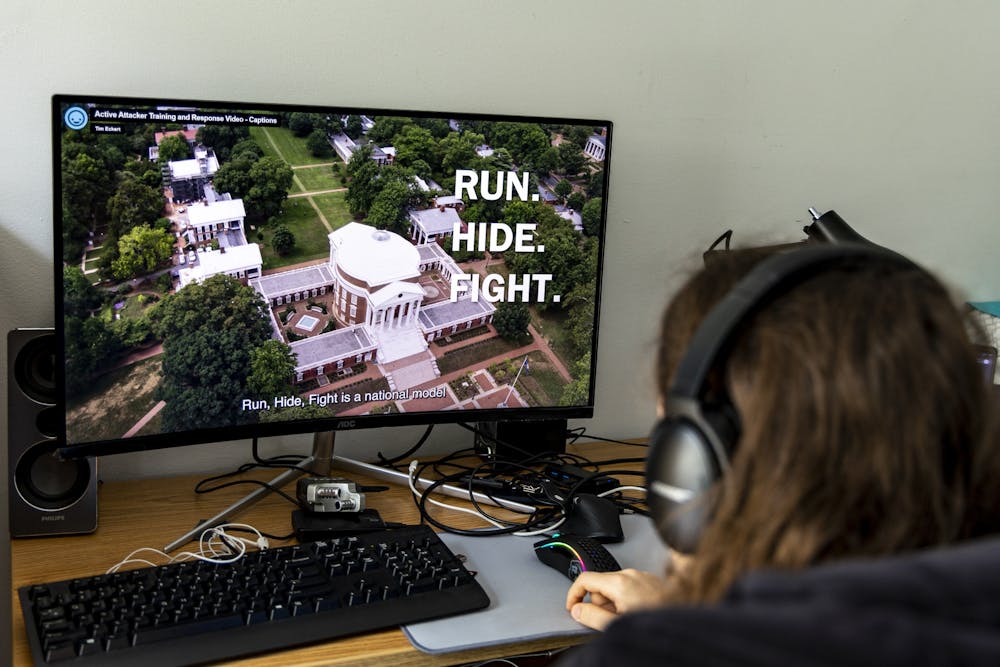When logging into U.Va.’s Student Information System over the summer, University students will notice a new requirement to complete before the fall semester begins — an active attacker training and response module. In the wake of November’s shooting, students will now be required to complete this training every two years.
The module, created by the University Department of Safety and Security, includes a seven-minute video with information from the University's threat assessment and emergency management teams, informing students on how to respond to an active shooter incident on Grounds.
The module appeared in the University’s Student Information System without prior notice by the University. An email sent Friday to the student body includes the training in the list of online education to be completed by Aug. 14 but does not provide any additional introduction to the video.
A trigger warning precedes the video, alerting viewers of violence. Most of the training depicts a simulated active shooter situation in familiar locations around Grounds, featuring people running from Newcomb, barricading in classrooms and hiding in the Student Health and Wellness building.
Unlike other educational modules, students may request an exemption to the active attacker training by writing vpsa@virginia.edu — a detail only revealed in Friday’s email.
University Police Chief Tim Longo said that the Department of Safety and Security decided to release the video following an increase in mass shootings across the country. Longo said the realistic depiction provides the most effective way to relay the information.
“To do it in a way that's more sterile doesn't have as much impact,” Longo said. “I think people need to see the environment that they would be in if, God forbid, something like this were to take place.”
Many of the first responders in the video are also University police officers, a choice that further helps students familiarize the possible response to a threat, according to Longo.
Some students, however, responded negatively to depictions of violence so close to home. Third-year College student Sofia Posadas said the active shooter simulation Grounds was somewhat triggering for her.
“Those are places that I go every day and to hear people screaming and reacting to a possible shooter on-Grounds, it triggered something in me,” Posadas said. “It was pretty scary.”
Posadas also serves as the communications lead for Students Demand Action at U.Va., a group advocating for gun reform in Charlottesville and the University community. According to Posadas, SDA’s chapter membership grew substantially following the Nov. 13 shooting on Grounds that resulted in the deaths of second-year College student Devin Chandler, fourth-year College student D’Sean Perry and third-year College student Lavel Davis Jr.
While she said she was happy the University was taking action to keep students safe after the recent tragedy, Posadas felt the video did not include enough new information. She cited the video’s explanation of the “run hide fight” slogan, which was already used heavily by the U.Va. Alerts System during the Nov. 13 shooting.
Longo said the training video began production in 2018 before he was hired as the University’s police chief. The original video, which the University never released, also featured interviews from various former University employees, but Longo decided to cut this portion of the video when finalizing the module.
“We wanted to put it into a version that was a bit more concise,” Longo said. “And it didn't make sense to me to have a bunch of talking heads at the beginning of it. I think what people really want to see is the heart of the video, which is to help people plan for, you know, the unthinkable.”
Longo said that the re-editing process for the video began last year before the Nov. 13 shooting on Grounds, but did not clarify which, if any, parts of the video were changed following the shooting. As for why the University never released the video in 2018, Longo said he did not know.
While this module is mandatory for students to complete, Longo said one of his goals was to make the video as accessible as possible to the general public.
“What I was very adamant about was, because this was not the case when the video was for was initially created, is that we make sure that we're able to put it online and that it's accessible to students, faculty, staff, parents — anyone who needed or wanted to see this video had to be able to see it,” Longo said.
The training is not mandatory for University faculty and staff, but is listed as “encouraged” viewing on its site. University spokesperson Bethanie Glover said over 5,800 faculty and staff members have already voluntarily opted to complete the module and others have been assigned to complete the module by division supervisors.
Aside from the newest training video, the DSS also offers optional de-escalation training available to students, faculty and staff looking to avoid conflict and aggression. Longo said that this classroom-style instruction has been in place for the past 18 months and has trained thousands of University faculty and staff members. He hopes to continue this de-escalation training in a more robust way across Grounds to include more students in these classrooms.
Posadas agreed that the active attacker module should be built upon with other safety measures for students in the future.
“I think it's a start, but it's definitely not a solution,” Posadas said.
Longo said that he hopes the requirements surrounding active attacker training will be reviewed on a yearly basis due to the importance of the topic.
“It's not a comfortable thing to see,” Longo said. “It's not a comfortable conversation to have but it's really a critically important one.”







